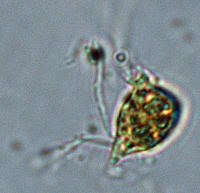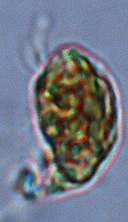| Cell | Chlorophyll | Pigments | Membranes | Thylakoids | Storage | Covering | Flagella |
|---|---|---|---|---|---|---|---|
| Eukaryotic | a and c2 | Phycocyanin or Phycoerythrin | 4 | 0-2 | starch and lipids | proteinaceous periplast | 2 equal |

| Public Domain | NOAA | Wikimedia Commons, Daniel Vaulot |
Cryptophytes, or cryptomonads, are single-celled algae that have two flagella, used for swimming.
The cryptophytes are single-celled flagellates and have pigments found in no other group of algae (phycoerythrin and phycocyanin). Pigments are structures that absorb light and include the pigment, chlorophyll. The name “crypto” means secret, or hidden, and these algae can be secretive in their life habits. Cryptophytes are an interesting group of organisms because they are able to obtain energy from the sun through photosynthesis, as well as obtain energy by eating particulate food. Therefore, these algae are both photosynthetic and heterotrophic. There are many different species found across the world, including moist areas on soils, ice-covered lakes, tropical oceans, in blooms on beaches, and as intestinal parasites in animals. There is still much to be discovered about this group of organisms and their life habits.
Cryptophytes contain chlorophyll a and c2 for photosynthesis, which they use for converting the sun’s energy into food. Cryptophytes save the extra energy from photosynthesis in the form of starch, a type of sugar. Starch acts as a food reserve for the cell during times when it is not able to photosynthesize, like in the darkness of winter or deep in lakes, where light does not reach. Cells also contain the accessory pigments phycocyanin (blue) or phycoerythrin (red). Accessory pigments are the molecules responsible for the color of cells, and cryptophytes may appear red, yellowish green, or brown in color.
Structure
Most cryptophytes are flattened and elliptical in shape and have 2 flagella. The cryptophytes have a unique cell covering called a periplast. The periplast contains ejectosomes (also called trichocysts), tightly coiled strands of protein which also contain poisons. These ejectosomes are a defense mechanism. A cell can eject the ejectosomes if it feels threatened by a predator, such as a zooplankter. The ejectosome distracts the predator and gives the cryptophyte time to swim away.
Cryptophytes are able to eat prey (heterotrophic) or use photosynthesis (autotrophic) to obtain energy for the cell. Cells are distinct because of a feature on the periplast called a furrow. Inside the furrow, or gullet, are more ejectosomes. The cells are able to engulf (eat) bacteria or other protoctists and the poison from the ejectosomes subdues or kills the prey. Cells also photosynthesize using chlorophyll and accessory pigments. Cryptophytes have additional pigments of alpha-carotene, cryptoxanthin and alloxanthin. These are unusual pigments within the algae, and because of them, scientists think that cryptophytes first evolved as heterotrophic organisms and later acquired (engulfed, but did not digest) photosynthetic symbionts. That is, cryptophytes are thought to have acquired symbionts more than once in their evolutionary history.
Cryptomonads in Rocky Mountain Lakes
In the aquatic environments of the Rocky Mountains, cryptophytes are a very important part of lake ecosystems. Cryptophytes are abundant in the phytoplankton and they can also live through the winter, under ice-cover and with little solar radiation for phytosynthesis. They are also an important food zooplankton. Zooplankton, in turn, are food for fish and other organisms that are part of the aquatic food web.
17 taxa shown below, 17 of which appear in at least one sample.
| Name | Basionym | Synonyms | Lakes | Samples | Region* | ID |
|---|---|---|---|---|---|---|
| Chilomonas sp. | 1 | 2 | RMNP, | 4001 | ||
| Chroomonas acuta | 4 | 29 | RMNP, | 4002 | ||
| Chroomonas sp. | 2 | 57 | RMNP, | 4003 | ||
| Cryptomonas alpina | 2 | 4 | RMNP, | 4015 | ||
| Cryptomonas erosa | 4 | 27 | RMNP, | 4004 | ||
| Cryptomonas marsonii | 4 | 24 | RMNP, | 4005 | ||
| Cryptomonas ovata | 1 | 1 | RMNP, | 4006 | ||
| Cryptomonas rostrata | 1 | 1 | RMNP, | 4007 | ||
| Cryptomonas sp. | 3 | 16 | RMNP, | 4008 | ||
| Cryptomonas sp. 1 | 1 | 2 | RMNP, | 4016 | ||
| Cryptomonas sp. 2 | 1 | 2 | RMNP, | 4017 | ||
| Plagioselmis nannoplanctica | 1 | 1 | RMNP, | 4009 | ||
| Plagioselmis sp. | 1 | 2 | RMNP, | 4010 | ||
| Plagioselmis sp. #1 | 1 | 148 | SLW, | 4014 | ||
| Plagioselmis sp. #2 | 1 | 112 | SLW, | 4013 | ||
| Rhodomonas minuta | 3 | 15 | RMNP, | 4011 | ||
| Rhodomonas sp. | 2 | 36 | RMNP, | 4012 |
Region:
RMNP = Rocky Mountain National Park, CO
SLW = Silver Lakes Watershed, CO
Images are not scaled. An individual that looks bigger than its neighbors might actually be smaller. All images were made to fit within an area of 360px high and 200px wide.
 Plagioselmis sp. #1 Length 10-12 µm Width 5-7 µm |
 Plagioselmis sp. #2 Length 10-12 µm Width 5-7 µm |
Representative images missing for: Chilomonas sp. | Chroomonas acuta | Chroomonas sp. | Cryptomonas alpina | Cryptomonas erosa | Cryptomonas marsonii | Cryptomonas ovata | Cryptomonas rostrata | Cryptomonas sp. | Cryptomonas sp. 1 | Cryptomonas sp. 2 | Plagioselmis nannoplanctica | Plagioselmis sp. | Rhodomonas minuta | Rhodomonas sp. |

